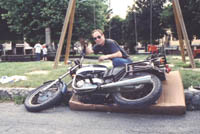
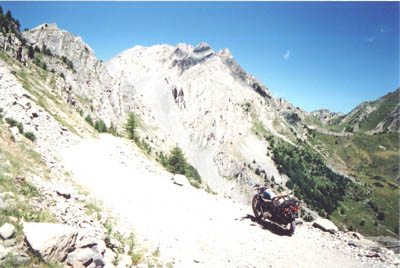
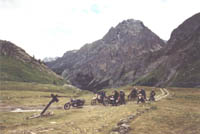
Stella
Alpina 2000
(or ĎOne week, five breakdowns - a Triumph
or a disaster?í)
By Bob Lane, Wilstead, England
 |
 |
 |
|
Last year, with my parents having volunteered to look after the kids, my wife Annie and I undertook our first European tour in many years, once again taking in Mario Artusioís infamous Stella Alpina rally in Italy. Keen on a challenge and fortunate to be invited, we also undertook the Stella Alpina "Safari" organised over the following days for the more dedicated, insane or masochistic, depending on your viewpoint. We limited our trip to a duration of just one week, conscious of the fact that the kids may just drive the folks to regret their decision! However, whilst our jaunt consisted of a somewhat mad dash in both directions, we enjoyed a reasonably relaxed time down in Italy, during which time we met old friends, made new acquaintances and had a great time. Consequently, earlier this year, with a view to repeating the exercise, I started dropping hints to both Annie and my parents. The folks had no hesitation in volunteering their services again(!), but to my surprise Annie decided to respect her long-term back problem and declined the offer of another week away on the bike. However, noting my disappointment, she offered me a one-week Ďpassí to nip down to Italy by myself. Whilst many would no doubt jump at such an offer, I did try to talk her into doing the trip. I finally announced that with limited time to prepare, a firm decision was required since the choice of which motorcycle to take was dependent on whether the comfort of a pillion passenger had to be considered. Little did I realise at the time, but this statement would remain long remembered since it stunned her into silence (a rare occurrence indeed!). The significance of the statement? Well the choice of bikes in this case was between our ultra reliable and trusted, if a little old, R80/7 or my 1972 Triumph 650 Tiger that had only been used on fairly local runs since I fully re-built it some 12 years ago. Now personally, I like British motorcycles of this era, and although Annie was clearly of the mind that reliability (or rather lack of it) was an issue, my Tiger had never let me down and, unlike the BeeEm, would return not less than 65 mpg. The only down side as far as I was concerned would be the need for some chain maintenance given that it was fitted with the old (non o-ring) Reynolds chain. The preparation The decision was made. A 28-year-old Triumph was the best machine for the job! Well of course it wasnít really - you only have to see the number of riders who Ďdoí the Stella on BMW twins! Preparation (Servicing) - Change engine oil, clean gauze oil filters, change gearbox oil, replace contact breakers and spark plugs, valve clearances checked, new Avons back and front, new control cables throughout, new fuel and oil lines, check primary chain and clutch adjustment, carb stripped and cleaned, final drive chain removed, cleaned and dipped in Duckhams Chain Guard (remember that stuff!), and finally clean and polish. Ah yes, cleaning! Always the best way of finding those little faults like the front mudguard that has just started to split near one of the stays and the stay that has sheared just inside the rubber mount on the fork leg. Never mind, I know a man with a MIG welder who does what looks like a pretty good job and it hasnít burned off too much of the nice metallic blue paint finish. Preparation (Spares) - Control cables, spark plugs, contact breakers, inner tubes, 2 litres of engine oil, numerous bottles of Millers VSP fuel additive, test bulb, insulating tape, wire, rear drive chain (two chains used in turn to prolong sprocket life), carb gaskets, selection of nuts, bolts and screws, bulb set, spokes, and 5-minute epoxy (an essential for BeeEm twin riders on the Stella for fixing holed sumps - no joke!) Preparation (Tools) - A lot! Preparation (Luggage) - Not liking tank bags and deciding that even one up, some serious luggage carrying capacity would be useful, I turned my attention to fitting the classic Krauser panniers from the R80 using a set of the old die-cast aluminium Krauser fittings complete with rear carrier. The design of the Triumph dictated that the panniers could not be fitted wholly to the rear of the shock absorbers as on the BeeEm and required new mountings to be produced throughout. Always being one to err on the side of caution (or had you already noted that by now!), I constructed the pannier mounts from 25mm x 5mm mild steel, which used up the contents of two very large butane canisters to put the required bends into the material. A coat of paint and some very smart zinc-plated cap head screws later and the finished result looked quite reasonable. The Holiday Day 1 - Thursday, 6th July. 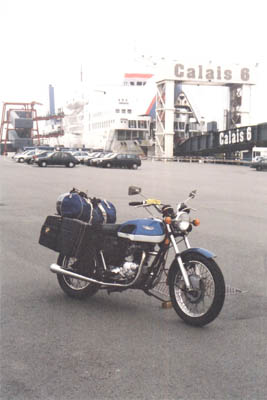 Having caught an early morning Dover-Calais ferry, during the crossing with good weather forecast and plenty of time to spare, I decided that a little detour on roads not previously travelled would make for a more interesting ride. Thus a lightning tour of Paris was decided upon. One hour later, having taken the obligatory first photograph of the holiday on the Calais dockside, Iím on the road, with the sun quickly burning off the early morning mist and the Triumph running as smoothly as a Triumph twin can. The miles pass uneventfully until Paris. Now Iím used to riding in heavy traffic, but Paris, that really does have to be seen to be believed. Eventually, I became so hot from alternately riding at little more than a stand still and then getting caught for ages at what seemed like every set of traffic lights, that the leather jacket had to come off (not something I would generally recommend) and tucked under the bungies with the tent. At last I found myself on the road just across the river from Notre Dame and was just contemplating where to stop for a quick photograph when the bike decided for me by running onto one cylinder. Just as I pulled over, a helpful(?) passing motorcyclist informed me that the bike was smoking from the RH exhaust. Knowing how hot the motor must have been, thoughts of a holed piston entered my mind, quickly followed by the disappointing prospect that for the first time ever, I may have to cut short a holiday (indeed, nigh-on before it had really begun) due to a mechanical breakdown.
Helmet off and bike up on the pavement, the problem was soon identified. Not a holed piston but one HT lead with melted through insulation where it laying across one of the rocker boxes and the original champion plug cap melted over the spark plug. The HT lead and plug cap on the other side werenít in much healthier condition either. Just as I was removing the luggage to gain access to the tool kit, an English holidaymaker came over enquiring as to the problem. Unfortunately, I really wasnít in the mood for passing the time of day at this point and following a brief conversation during which this chap made mention of being a member of the BSA Ownerís Club, he departed. Minutes later and he returned, presenting me with an ice-cold can of drink before wishing me luck and continuing on his way. Not worth noting you may think, but that gesture raised my spirits as much as if someone had placed a new set of HT components in my hand. Several layers of insulating tape around the melted components and a top up of engine oil later, I was back on the road but stopping at regular intervals to take photographs whilst giving the engine some brief cooling periods. South of the city and in a motorcycle accessory shop I bought new (and very expensive!) silicon HT leads and NGK plug caps; my lack of ability to ask for the parts in French being overcome by saying "NGK" and drawing a sketch. Having by now lost a fair amount of time, I then pressed on, riding through Fontainebleau and taking the more minor D905 route towards Dijon. Riding until near last light, the tent provided my overnight accommodation erected on a wide area of verge where I could discreetly camp out of sight from the road. Day 2 - Friday, 7th July The camping kit was soon packed away for another early start on the road. Unfortunately, rain having arrived overnight necessitated the use of the wet weather gear - so much for my hope for fine weather throughout. First fuel stop of the day was at Genlis, east of Dijon. Having filled up, with the tank paintwork looking exceeding grubby from a mixture of road dirt and fuel residue from the less than perfectly sealing filler cap, I decided that a quick once over using the forecourt windscreen washing facilities to be in order. However, on returning to the bike from paying for the fuel, I was surprised to see water still dripping onto the ground. Surprise then turned to alarm when I realised that the dripping liquid was not water! Luggage off and tool kit out again, the fuel tank was quickly removed to reveal a split along a weld on the underside of the tank at the point where it provides for the fixing bolt to be passed through. The offending area was quickly cleaned up and a layer of 5-minute epoxy applied. A short while later I was back on the road. Being keen not to push my luck with this repair I figured that since the split was fairly high up on the tank, only a few litres of fuel would need to be consumed to get the fuel level down to below that of the split.
Over the next hundred miles or so, the weather improved dramatically and I was really enjoying the ride towards the Alps with thoughts that my problems must by now surely be over. Wrong! Stopping for fuel at Albertville (making sure not to fill the tank above the problem level), on returning to the bike it flatly refused to start. It soon became apparent that there was no power reaching the ignition circuit but luckily the broken connection at the main fuse holder was quickly identified. A repair was quickly effected and it was then back on the road - next stop Bardonecchia! As it happened, I actually made several stops on route but only to take photographs - the ride over the Col du Galibier affording some excellent views in particular. Stopping on this pass, the Triumph soon attracted the notice of several other Brit riders who were also heading for the Stella. Although the brakes on the laden Triumph were performing surprisingly well, I chose not to push my luck in attempting to keep up with the others for the decent and final run to Bardonecchia. Day 3 - Saturday, 8th July. Whilst many riders attending the Stella Alpina rally now favour hotel accommodation over camping, being a "hardened biker" it was camping on hard ground and without an airbed for me! (Well actually, having left the family at home, my conscience would not let me over indulge on accommodation even though hotel rooms can be had for a reasonable sum.) The morning was spent renewing old acquaintances from previous Stellas and meeting up with a couple of friends who I had talked into coming to the event. Unfortunately, due to work commitments, they could not travel down until the Friday and planned to be back home by the following Monday evening. However, given the problems that I had experienced on route, I was glad that we had not travelled down together with my being a burden to them. It was during the afternoon that someone suggested a quick run up to a local viewpoint called Tre Croci (3 Crosses). It is perhaps fair to advise anyone visiting Bardonecchia that should you choose to undertake this run, I would not recommend undertaking this ride alone. The narrow track consists of a mixture of large cobblestones, potholes and mud, steeply winding up the side of a mountain to an elevation of some 2700 feet above the town. The reward is an excellent view from the top. On the down side (excuse the pun), there is a very real risk of dropping your pride and joy. This year a French friend of many years off-road riding experience dropped his K100 on three occasions, resulting in a fair degree of cosmetic damage to the bike, and last year, a chap on a large Suzuki ending up being trapped under his bike with fuel dripping onto him until help arrived. That said, donít be put off giving the Stella Alpina a try, since the off-tarmac run up the Colle del Sommeiller is generally considerably less hazardous. However, back to the 3 Crosses excursion. With one of the guys amongst us having a CBR600 Honda, he rightly decided that his bike was not suited to this run so, the fool that I am, I volunteered to take him pillion. The ascent went well for the most part although during the climb the altitude began to significantly reduce low engine speed performance. Towards the top, I was forced to slip the clutch to negotiate the regular and steep hairpin bends. Big mistake and holiday breakdown No 4! Less than half a mile from the top and all drive through the clutch was lost. Slackening the clutch cable and leaving the bike for over half an hour to cool off failed to right the situation, and not having a box spanner to effect an adjustment on the clutch itself, left no choice but to freewheel the Triumph all the way back down the track. Indeed, it says something for the gradient of the track and some of the roads in Bardonecchia that I was able to freewheel for some 20-30 minutes, making it to within a few yards of one of the main garages, before I had to push. At the garage, the necessary spanner was borrowed, but unfortunately, such was the wear on the clutch plates, that the main adjuster screw separated from the clutch housing before the pressure was released from the clutch push rod; not good! Short of replacing the clutch friction plates (6 items of spares that I hadnít brought with me!), the only possible quick fix I could think of was to remove the clutch push rod and reduce it in length by the total thickness of friction material lost on the clutch plates. Thus, the push rod was removed without too much difficulty through the clutch adjustment aperture and the garage bench grinder used to remove some 4 to 5mm off the end. I did give some thought to re-hardening and tempering the end of the push rod but having been careful not to overheat the end during grinding, decided that this was not necessary. On assembly, all appeared to work OK and even though the clutch springs were now working under considerably less pre-load, clutch engagement permitted the engine to be started. With every intention of "doing the Stella" on the Triumph the next day (and indeed, of attending the Safari runs on the following days thereafter), whilst I would not be riding two-up, I was concerned about the weak spring pressure holding the clutch plates together. A decision was made - the primary drive cover would have to come off and the internal spring adjustment screws tweaked to restore the status quo. In the absence of the factory tool (Iíve got one at home!), all that was needed was a large slotted screwdriver. No problem - a visit to the local tool store later and I fashioned the required item out of a tyre lever with a newly acquired mini-hacksaw and file. Having also purchased a box spanner to fit the main adjuster lock nut, I figured that should any more shortening of the (albeit toughened) push rod be subsequently necessary, I would at least now be self sufficient to effect the repair. Being early evening by now, thoughts of a partial dismantle job were put off until the next morning in favour of joining the others for a meal and beverages. Day 4 - Sunday, 9th July. Up early, I decided to ride the bike from the campsite and effect the surgery in a large car park opposite the hotel where most of the others were staying, surmising that at least help would be readily available should I need it. As it happened, another Brit was also working on his Triumph (a Trophy Trail (TR5T?) on which the tab washer had failed to stop the mainshaft nut unscrewing itself) and the use of his socket set made my job all the easier, particularly in performing the necessary removal of the LH footrest. A low wall, which I covered with cardboard packaging borrowed from a skip outside the local bicycle shop, permitted the bike to be lent over, negating the worry of losing the oil contents from the primary drive and in no time the job was done. In a total contrast to the damp conditions and muddy track of last year, this yearís run up the Colle del Sommeiller afforded generally dry conditions albeit with a fair amount of dust being kicked up by the steady stream of motorcycle traffic. The run up the mountain track with two friends who had decided to wait for me to fix the bike, brought with it the usual stunning scenery and regular stops were made for photographs. A considerable thaw permitted the Stella rally control to be established right at the top of the track this year in a dilapidated ski lodge on the Colle, where we registered and bought the obligatory badge and tee shirt. Apart from more splendid views looking over into France as well as back down the valley we had just ridden up, entertainment was provided as usual by numerous nutters on their motocrossers negotiating the substantial area of snow. The really keen ones were making it up considerable gradients with their departures from their bikes or just getting stuck in the deep snow being met with cheers from the onlookers. 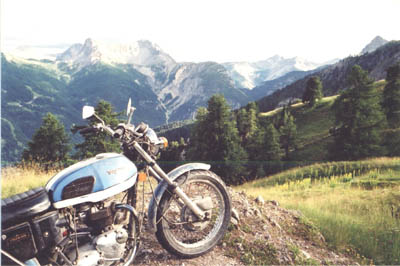 Back on the bike and riding alone down the track, a French friend on his K100 accompanied by some Germans on large GSs caught up with me. A stop for a chat established that, not having had enough of rough-stuff riding, they were intent on extending their run to take in the 3 Crosses; they not having been on this run the day before. Not wishing to accept defeat from my previous attempt, I just had to take advantage of this opportunity and an hour later we had negotiated the climb and were admiring the view from the top. Unfortunately, as mentioned before, the K100 was looking somewhat worse for wear by the time we got back to Bardonecchia, the bike having taken the odd tumble. That evening, the conversation inevitably turned to the subject of the Safari which this year would see us relocating some 50 miles (but a lot further by road!) SE of Bardonecchia to explore the mountain tracks in that region. Compared to the Stella Alpina itself, the Safari remains a low-key, personal invitation, event and provides generally no more than 20 riders with a further opportunity to ride off the beaten track. Day 5 - Monday, 10th July onwards. Monday brought with it rain - not the best of conditions under which to have pack up the tent. The next few hours were then spent in the company of a Brit rider on an R80GS riding in pretty appalling conditions, but at least as we reached our final destination, the weather was showing signs of improvement. Now located in a small village some 30 miles west of Cuneo, I took advantage of the very favourable arrangements that Mario had negotiated for accommodation, breakfast and evening meals. 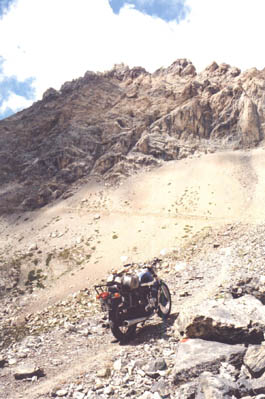
The next three days were spent exploring mountain tracks that afforded many more photographic opportunities and brought with it memorable events such as having to clear earth slides, riding through a blizzard (although down in the valley the weather had been fine) and one breakdown. Wrong! - not my Triumph but our French friendís K100 with a broken clutch cable. All too soon Friday dawned and it was time for me to head for home. The farewells having been said (and bill paid) the night before, I was on the road shortly after 6am and made good progress all the way to Turin where I managed to get lost whilst negotiating the morning rush hour. However, after Turin, respectable progress was made towards the Grand St Bernard Pass, where during the ascent, sunny weather gave way to rain that in turn gave way to a blizzard. At the border crossing at the top, with me by then being nicely covered in a thin layer of snow, even the guard took pity on me and just waved me through. Previous years, we have been questioned as to our intentions for transiting Switzerland; they being very keen to sell costly passes for using their autoroutes. Descending into Switzerland, riding through the blizzard was problem enough when the Triumph decides to throw one more problem at me by running onto one cylinder. The problem was quickly diagnosed as being due to the welded seam on the fuel tank chaffing though the rubber collar that seals the spark plug cap at the entry point of the HT lead. Unfortunately, even the smallest NGK caps sit too high for this bike, but drying off the offending area as best I could and the application of some insulating tape soon had me back on the road again. Not using the autoroutes, Switzerland took ages to cross and in rain for the most part. A new lesson for travelling in Switzerland was also learnt - that of donít expect to always be able to pay for fuel by credit card. Unless I was just unfortunate with the area that I was in at the time I needed fuel, all but one garage that I came across were of the unmanned, automated type, requiring either a currency note (of which I had none) or a credit card to be inserted into a forecourt machine. At these fully automated stations it would appear that credit cards issued in the UK are not accepted! Late in the afternoon and still raining, I entered Germany and headed north on the autobahn. Riding until well after sunset, an overnight stop was made in one of the autobahn minor rest areas near Koblenz - the tent again being used. Saturday and not knowing the legality of camping in these places, I was packed up and on the road again at first light and even the weather was improving. With stops for alcohol-based provisions on route, the run continued through Holland, Belgium, and France, and by late afternoon I was back in Dover. Early evening and I finally I arrived home in Bedfordshire to see that the kids (no doubt with some significant encouragement from my Annie) had decorated the garage door with a large banner reading "How many breakdowns?!!" Since returning home, the question of "Would I do it again?" keeps entering my mind. Given similar circumstances (in particular that of travelling alone so as not to be a possible burden on others) the answer is definitely yes, since for all the swearing under my breath at each breakdown, fixing each problem brought with it a real sense of achievement. There again, maybe Iím just certifiable! |